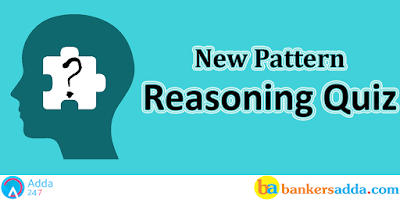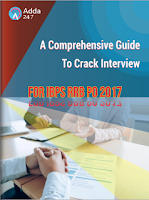Dear Readers,
The reasoning is a game of wits and presence of mind! Yes, it is true and it might seem as the greatest of the challenge after English Section’s surprises but yet this one can easily be dealt with. You just need correct practice and hardwire your brain to quickly make decisions about what to attempt and what to leave. And for same we are providing you questions of Reasoning Question and Answers. Solve these to Practice latest pattern reasoning question for bank exams.
Directions (1-5): Read the following information carefully and answer the questions given below:
There are eight people P, Q, R, S, T, U, V and W are sitting around a circulat table for the lunch. Some of them are facing towards the center of the table while some are facing opposite to center of table. They all are of different age viz. 18, 27, 15, 19, 13, 17, 11 and 31 year, but not necessarily in the same order.
P is sitting third to right of R. P’s age is 31 year.There is one person sitting between P and Q. S is sitting fourth to right of Q. The one whose age is 15 year sits second to right of S. Three persons sit between the one whose age is 15year and the one whose age is 31year. The one whose age is 18year sits second to right of one whose age is 31 year. The age of S is not the 18 year. The one whose age is 17 year sits third to right of one whose age is 18 year. R’s age is 17 year. There is two persons sits between S and T. There is three persons sits between the one whose age is 13 year and the one whose age is 19 year. T’s age is neither 13 nor 19 year. T faces towards the center of table. There is only one person sits between the one whose age is 19 year and the one whose age is 27 year. The one whose age is 15 year sits third to right of one whose age is 27 year. The one whose age is 11 year sits third to right of one whose age is 19 year. V sits fourth to right of one whose age is 13 year. U is not immediate neighbor of V. The one whose age is 13 year sits third to left of one whose age is 15 year and both faces the same direction.(Same direction means if one faces center then other also faces the center and vice-versa).
Q1. Whose age is 15 year?
(a) P
(b) Q
(c) R
(d) T
(e) W
Q2.If T is related to R and Q is related to S, in the same way P is related to?
(a) U
(b) Q
(c) V
(d) T
(e) W
Q3. Who among the following sits third to right of one whose age is 31 year?
(a) U
(b) S
(c) V
(d)W
(e) E
Q4. Which of the following is correctly matched?
(a) T-18
(b) R-15
(c) S-11
(d)U-19
(e) W-17
Q5. Who sits opposite to one whose age is 18 year?
(a) U
(b) The one whose age is 19 year.
(c) R
(d) The one whose age is 31 year.
(e) The one whose age is 11 year.
Directions (6-10): Study the information and answer the following questions:
In a certain code language
‘best are now in’ is written as ‘sx pt fa ma’,
‘all are best content’ is written as ‘pq ma vx fa ’,
‘they are writing content’ is written as ‘vx mn fa ca’ and
‘all they often consume’ is written as ‘la xa mn pq’.
Q6. What is the code for ‘now’ in the given code language?
(a) fa
(b) pq
(c) sx
(d) pt
(e) Can’t determine
Q7. What is the code for ‘all best’ in the given code language?
(a) pq ma
(b) pq ca
(c) sx ca
(d) fa ca
(e) ma vx
Q8. What is the code for ‘consume’ in the given code language?
(a) la
(b) xa
(c) mn
(d) either(a) or (b)
(e) either (a) or (c)
Q9. What is the code for ‘content’ in the given code language?
(a) fa
(b) sx
(c) pt
(d) either(a) or (b)
(e) vx
Q10. What is the code for ‘writing’ in the given code language?
(a) mn
(b) ca
(c) vx
(d) la
(e) pq
Directions (11-13): Question consists of five statements followed by five conclusions. Consider the given statements to be true even if they seem to be at variance with commonly known facts. Read all the conclusions and then decide which of the given conclusions does not logically follow from the given statements using all statements together.
Q11. Statements: Some sponge is pant. All pant is cloth. No cloth is square. All jeans is square. Some jeans is cap.
Conclusions:
(a) Some sponge is cloth.
(b) Some sponge is not square.
(c) No pant is square.
(d) Some cap is square.
(e) None of these
Q12. Statements: All jan is man. Some jan is march. All march is april. No march is gun. Some gun is july.
Conclusions:
(a) Some jan is april.
(b) Some march is man.
(c) Some april is not gun.
(d) Some july is april.
(e) None of these
Q13. Statements: Some nike is lava. Some lava is iron. Some iron is nokia. Some nokia is rod. Some rod is xiomi.
Conclusions:
(a) Some lava is nike.
(b) Some xiomi is rod.
(c) Some nokia is lava.
(d) Some rod is nokia.
(e) None of these
Directions (14-15): In the questions below are given some conclusions followed by five set of statements. You have to choose the correct set of statements that logically satisfies given conclusions either definitely or possibly. Assume the given statements to be true even if they seem to be at variance from commonly known facts.
Q14. Conclusions: Some dark is white. Some black is not white.
Statements:
(a) Some back is green. No green is white. Some white is fair. All fair is dark. No dark is violet.
(b) Some black is white. All white is green. No green is fair. Some fair is dark. All dark is violet.
(c) Some fair is dark. All dark is violet. No violet is black. Some black is white. All white is green.
(d) Some fair is violet. All violet is dark. No dark is black. All black is white. Some black is green.
(e) None of these.
Q15. Conclusions: Some wind is air. Some air is sky.
Statements:
(a) Some sky is air. All air is blue. Some blue is tree. All tree is wind. Some tree is nose.
(b) Some sky is tree. All tree is wind. Some wind is nose. All nose is blue. Some blue is air.
(c) Some sky is nose. All nose is blue. Some blue is air. All air is tree. Some tree is wind.
(d) All sky is blue. Some sky is air. Some air is tree. All tree is wind. Some wind is nose.
(e) None of these.
You May also like to Read:




 Reasoning Quiz For Bank Foundation 2024 ...
Reasoning Quiz For Bank Foundation 2024 ...
 Reasoning Quiz For Bank Foundation 2024 ...
Reasoning Quiz For Bank Foundation 2024 ...



